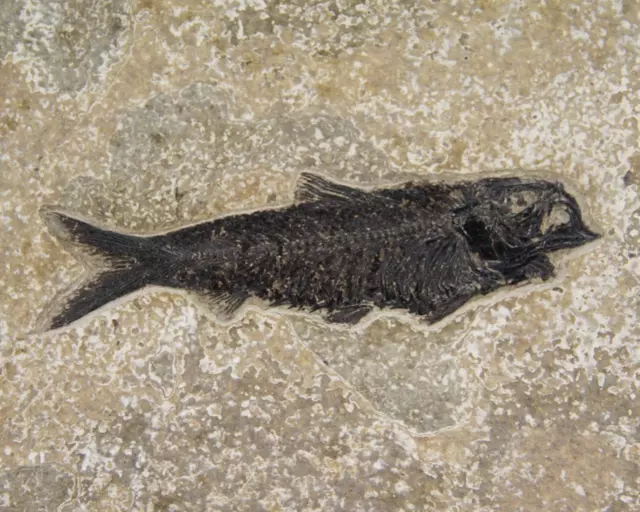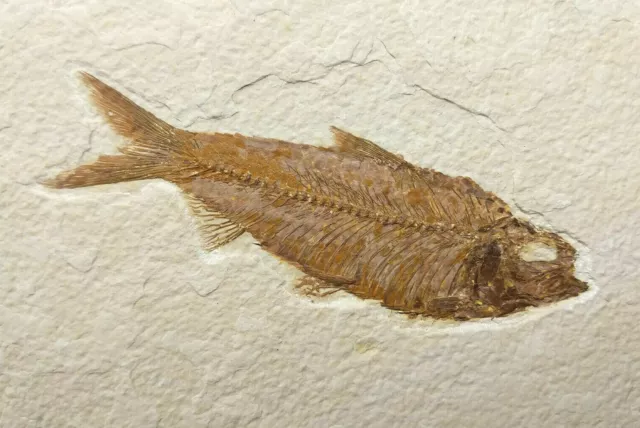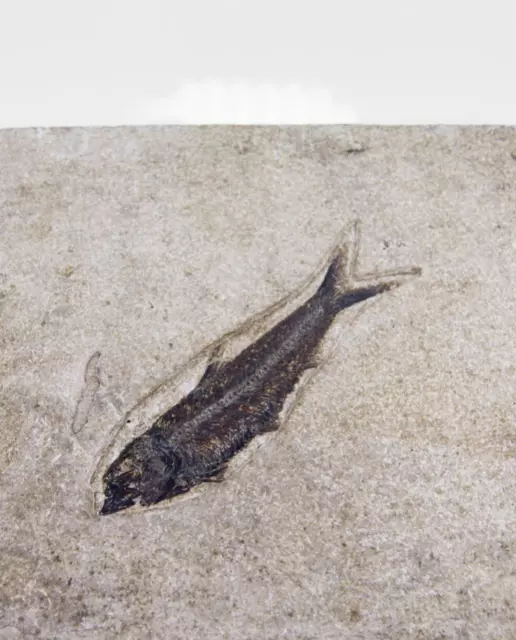Fossiler Fisch knightia sp. Wyoming, USA Größe: 200 mm
A superb single plate with a fine Knightia Alta fossil fish measuring 220mm exhibiting subtle and delicate palettes throughout. Incredibly well preserved in the calcite bearing shale which was once the mud of an exotic prehistoric lagoon. The plate has been created by lifting the shale which is now part of the Rocky Mountain range in Wyoming. Once lifted the shales are split in an attempt to recover these rare occurrences of preserved fish skeletons. This particular fish is complete and displays excellent morphology for study. While also creating a superb and beautiful display, now encased in an oak frame and ready to hang.
The Knightia Alta fossil fish an ancestor of the herring family, a very finely boned fish which is extremely difficult to prepare from the Lagerstätte varve layer of the Eocene limestones of the Green River formation 18-inch layer. These predator fish of an ancient freshwater lagoon have been discovered with other prey fish in its stomach contents, Knightia Alta, Knightia Eocaena and Priscacara Serrata all other inhabitants of the prehistoric fossil lakes and have occasionally found to the latter fishes stuck in its gullet. These so-called aspiration deaths are rare, difficult to interrupt as to the actual cause of the death of the predatory fish. The two main theories as to why aspiration fish deaths are found in the fossil deposits are, firstly the predator fish could not swallow the prey which became lodged in its throat and suffocated the attacker. Alternatively that the deoxygenation of the lake suffocated all fishes including the fish in the act of hunting and feeding.
The lower Eocene deposits of Green River formation was thought to be a large freshwater lake or lagoon which often suffered from falls of volcanic ash smothering the lagoon and creating an anoxic environment. This reduction of oxygen suffocated the inhabitants of the lake, this circumstance preserved exceedingly well the fishes and fauna of this region, a unique occurrence in the fossil record. The lack of oxygen gave little chance for bacteria to quickly establish and decay the fishes, flora and other fauna deposited in the muds at the bottom of the lake which would eventually be transformed into soft calcite bearing shale. The calcite would be absorbed by the remains of the fish, transforming their bones into a hard mineralised deposit in the slightly softer and lighter coloured limestone shales.
The fossil formation was discovered and described by Edward Drinker Cope in 1877 an American palaeontologist and comparative anatomist. In the last quarter of the nineteenth-century fossil collecting was so popular a personal feud between two great palaeontologists grew in momentum, Cope and another palaeontologist Othniel Charles Marsh became intensely competitive in discovering new dinosaur fossils, this led to a race of collecting termed the bone wars.
The eighteen-inch layer is a lower Eocene varve layer, is not fissile laminae and therefore much more difficult to split and work successfully, older in the fossil lakes system containing fish which have been preserved which calcite mineralisation. The mineralisation is caused by absorption of localised mineral elements being absorbed by the process of osmosis. Water coursing through the mud layers at the time of deposition deposited minerals in the tissues of the fish, in this case, its skeletal elements, bones teeth and cartilaginous parts. In this 18 inch layer, this exhibits in a dark calcite skeleton encapsulated in light coloured limestone of the Lagerstätte fossil varved lime muds. The mineral preserves every fine detail of this particular fossil bed, a very rare occurrence indeed.
Genus: Knightia Alta. Order Clupeifomes, Family Clupeidae.
Age: Eocene, 56,000,000 to 33.9,000,000 years.
Origin: Green River Formation, Wyoming, USA.
Knightia plate measurements.
Height: 21.0 cm
Width: 22.0 cm
Thickness: 1.5 cm
Weight: 1.248 Kg
Supplied with full photographic ID certification of authenticity, and free postage to the United Kingdom mainland.Postage Info:
PLEASE NB ; we only deliver free to the MAINLAND UK - FREE UK POSTAGE only which is quoted for standard areas only.
Additional postage to the following areas Scottish Highlands, Isles & Islands, North & Southern Ireland.
All other isles off the mainland may also be subject to surcharges.
Please contact us for a quote before placing your order if you are in any doubt, unfortunately, we may have to cancel orders where the appropriate shipping charge has not been paid. This only applies if posting abroad or outside of the mainland UK and depending on your location.
- Condition: Neu
- Sub-Type: Fish
- Type: Fossils
- Shape: Natural
- FISH TYPE: Knightia eocaena.
- Country/Region of Manufacture: United States
- Finish: Unpolished
- Modified Item: No
PicClick Insights - Fossiler Fisch knightia sp. Wyoming, USA Größe: 200 mm PicClick Exklusiv
- Popularität - 0 Beobachter, 0.0 neue Beobachter pro Tag, 1.083 days for sale on eBay. 0 verkauft, 1 verfügbar.
- Bestpreis -
- Verkäufer - 2.469+ artikel verkauft. 0% negativ bewertungen. Großer Verkäufer mit sehr gutem positivem Rückgespräch und über 50 Bewertungen.
Die Leute Mochten Auch PicClick Exklusiv

Fossil Fish knightia sp. Wyoming, USA Size: 338 mm
EUR 216,73 Sofort-Kaufen 13d 1h
Extra Large 6.5” Double Fish Knightia Fossil Plate Wyoming
EUR 139,97 Sofort-Kaufen 16d 11h
Genuine Fossil Fish Knightia from Wyoming USA Eocene fossils ref: WS10.KTF
EUR 119,50 Sofort-Kaufen 15d 1h
A Grade Knightia eocaena Fossil Fish Green River Formation Wyoming
EUR 53,75 Sofort-Kaufen 21d 11h
Genuine Fish Fossil from Wyoming USA (Knightia Alta) you select
EUR 21,78 Sofort-Kaufen 18d 10h 1 beobachter
1 beobachterfossiler Fisch, Wyoming, green river, Knightia ca. 7cm
EUR 6,50 Sofort-Kaufen


